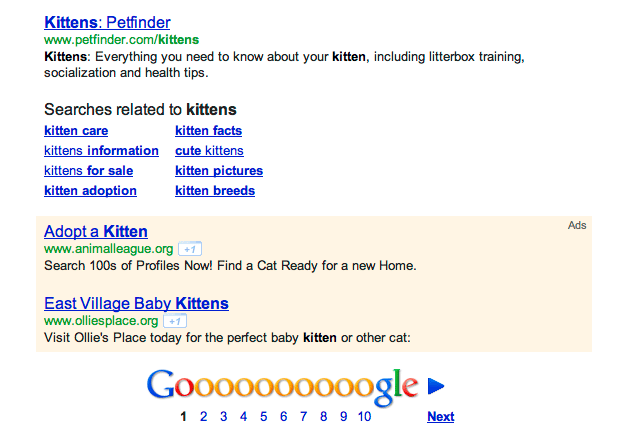As if the world of paid search advertising management wasn’t filled with enough variables…let’s throw in AdWords making changes to how they display ads!
On November 2, 2011, AdWords announced that “ads that have previously shown to the side of the results may in some cases appear below them.” When and why will the move to the bottom of the page be triggered? Google only says that they “dynamically optimize each page…to provide the best experience for our users.”
Here’s an example of what the new ad placements will look like:

Some observations:
- This appears to be in line with what some have called the “tabletification” of Google; Google making everything as simple and clean as works best on mobile interfaces.
- Most strikingly, it appears that when this occurs there will be a lot fewer ads on the page. Conventional “top and side” SERP’s have shown up to 11 ads per page. Assuming three ads at the top, the example page shown above would bring that down to five.
- The bottom ads appear to be given the top-of-page treatment (sort of): they run the width of the page and are in a shaded box. However, at least in the examples shown, they do not appear to have the top-of-page feature of moving the first body line up to the headline if it is a complete sentence.
Predictably, on Twitter I saw a lot of concern about this among paid search marketers. At first glance, it certainly doesn’t appear that this could be a good thing. Fewer ads on the page? Moving to the bottom where we’ve always been told few people go? What’s to like here.
I actually have some faith that this could turn out to be a good thing for us. Here’s why:
- Google said they instituted this change after extensive testing, and that the bottom ads actually performed better than side ads in terms of click-through rates.
- How can that be? Google says ads at the bottom fit better “into the user’s flow as they scan the page from top to bottom.” This also fits with research that seems to show that “below the fold” as a no-go zone is a myth.
- I don’t view fewer ads on the page as a bad thing. Fewer ads mean more chances that the ads showing will be seen and read. When you consider the data that side ads below the top few get very few clicks, you really aren’t missing much by not having the ninth ad on the page anymore.
The one negative (or at least potential hassle) I see in this is being able to properly assess and bid for this change in AdWords. Google says that now all side, bottom, and “experiment” impressions will be lumped into “other” in the relatively new “top vs. side” segmentation available in the AdWords interface. (In keeping with that, Top vs. Side will soon be renamed Top vs. Other.) It would be nice to have the bottom impressions in their own segment, although perhaps bidding toward that position might be futile since it occurs “dynamically” (i.e., as an instantaneous judgment of the Google algorithms that in this particular instance the user will be better served with the side space being used for features other than ads.)








